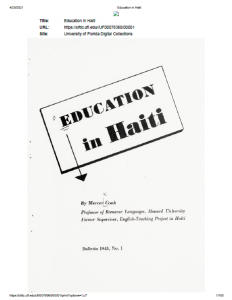THE DEVELOPMENT ARCHIVE
THE DEVELOPMENT ARCHIVE
EKO Haiti Development Archive serves as a clearinghouse of reports submitted by development and aid organizations, policy reports and recommendations developed by in-country experts to address problems in development and aid and other academic and literature-based documents.



In early 1986, the government of Haiti began a series of economic reforms in agriculture designed to reduce the degree of government price intervention, to increase efficiencies in the agricultural sector, and to reduce restrictions on the quantities of food imports. The critical extent of hunger and malnutrition in Haiti has underscored concerns by USAID and other donor organizations for the need to consider the impacts of agricultural policies and food aid on the agricultural sector, government finances, and food availability.


The USAID Agroforestry Outreach Project (AOP) began In late 1981. One of its goals was to provide the Haitian farmer with an additional cash crop by encouraging him to grow trees in an agroforestry system. This would simultaneously reduce Haiti's soil losses and other environmental problems. One of the original concepts of AOP was to have a research component to support project needs. Although it was presumed that the Grantees (The Pan American Development Foundation PADFS, Operation Double Harvest *ODH$, and CARS) would undertake their own internal research programs, their planting and outreach programs consumed all of their available time and resources. By the time of the "aid AOP review, it had become apparent that an independent contractor was needed to design and Implement the necessary research. Thus, the University of Maine (U of M) was selected to conduct studies in the following areas: Traditional Haitian Agroforestry Systems, Silvicultural Studies, Nursery and Outplanting Techniques, Species Trials, Cost-benefit Analysis of Agroforestry Systems.


There are many reasons for planting AOP trees beyond the original intent of cash-cropping, including improving fallow, providing shade, producing forage, and reducing soil erosion. All of these benefits of planting trees increase .the wealth of the farmer or prevent it from falling, even if they do not increase the farmer's cash flow.




